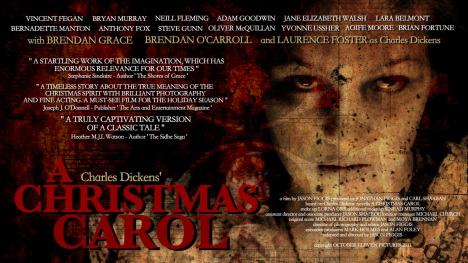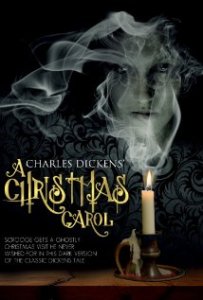 2012 gives us one of the newest kids on the block when it comes to versions of A Christmas Carol. It is also the first Irish version to join the ranks. This adaptation promotes itself as trying to reclaim the darker aspects of the Dickens classic.
2012 gives us one of the newest kids on the block when it comes to versions of A Christmas Carol. It is also the first Irish version to join the ranks. This adaptation promotes itself as trying to reclaim the darker aspects of the Dickens classic.
Originally only available as an online offering in 2012, it was finally released on DVD earlier this year.
 This is a version that had so much potential but unfortunately didn’t deliver. Whatever is good or bad, though, it is sincere in its attempt! It could have been one of the more unique versions if its concept had been fully realized. Who knows everything that can be blamed in preventing its potential achievement, but some of the reasons are apparent in the finished product.
This is a version that had so much potential but unfortunately didn’t deliver. Whatever is good or bad, though, it is sincere in its attempt! It could have been one of the more unique versions if its concept had been fully realized. Who knows everything that can be blamed in preventing its potential achievement, but some of the reasons are apparent in the finished product.
Despite a cast of experienced actors, most of the acting is uneven: sometimes good, sometimes flat. Also, it uses a fairly minimal cast, avoiding extra actors and reducing groups. Throughout much of the film the acting seems almost subdued as if trying to present some type of forced subtlety. Who know if this is the fault of the director’s vision or the actors. Vincent Fegan does well as a crotchety Scrooge but fails when he should be regretful, sad, and even happy.
One of the successes with the film is its attempt to draw from Dickens’ text as faithfully as possible. This is also one of a handful of versions where the narrator is represented as none other than Charles Dickens’ himself.
Staying true to its traditional nature, the story opens with Scrooge at – and then leaving – the church for Marley’s funeral. The atmospheric pace is set immediately in the opening. However, the settings themselves are a part of what is wrong here. None of the locations look even remotely like London or even urban for that matter (it was filmed entirely in the Republic of Ireland). Both the exterior and interior settings appear to all be location based with an attempt at authentic places of the story’s period. While the exteriors look mostly like country houses, the interiors seem to be museum-like rooms where permission was given to film. It’s almost like a lower budget attempt at the style of authenticity in Kubrick’s Barry Lyndon film. So… Scrooge & Marley’s counting house has large, slightly ornate multiple rooms. Scrooge’s dwelling is a very well decorated and cared-for location, not at all in keeping with his character. We only see the Cratchits’ kitchen, but even in the location’s antique simplicity, it is too well-off for how poor we know the family is supposed to be.
The Ghosts are very well done and I think this is where the movie lives up to it’s promise. They are just spooky enough without (very thankfully) going for anything Hollywood style. The Ghost of Christmas Past has a slight reminiscence of the 1935 Seymour Hicks film: it is visually female but voiced by a male. The Ghost is never seen with lips moving when speaking, making it effectively eerie. The Ghost first comes to Scrooge as he is laying flat on his bed and the Ghost’s face hovers over Scrooge from in back of his head – this reminds me of one of the ghosts from the Japanese movie Ju-on (The Grudge) that make a similar appearance. When Scrooge and the Ghost of the Past are viewing the events in his life, they are in framed mirrors or pictures on the walls. I really liked that innovation!
The Past scenes are where it becomes more apparent that this film is working with a minimal cast. In the Fezziwig flashback, we only see Scrooge and Dick Wilkins with Fezziwig. The ball is skipped completely. The scene with Belle is one of the most faithful out of the novella and had the potential to be one of the best scenes. But the acting is so flat that it’s almost emotionless, causing the scene to falsely feel like it’s too drawn out (when it’s really not). The scene with the later, married Belle as the “comely matron” is missing her children and is done simply with only Belle and her husband (this was also done in the 1977 BBC television version).
The Ghost of Christmas Present was slightly disappointing in that his costume wasn’t as traditional as I usually expect. The amount of Cratchit children is reduced and Mrs. Cratchit is like a cardboard cut-out that talks! At the home of Fred and his wife, the movie sticks with minimalism having only the two of them without any gathered friends.
The Ghost of Christmas Yet to Come is very traditional but manages to convey some frightening innovation with its diseased looking hands. In these scenes is more continuous, drab acting and small changes that are the obvious result of using the museum-like period rooms borrowed for the filming. As the authentic bed for Scrooge is not a four-poster and lacks bed curtains, it is his window curtains that are stolen “rings and all” instead. The future is where the Bob Cratchit performance is well acted as he cries for deceased Tiny Tim; during this, the rest of the Cratchit family seems completely numb or stoned.
The weakest part is the reformed Scrooge. There is no real happiness or excitement that is well portrayed. While many productions are guilty of going too far during this part, the opposite is happening here.
A standout for me was the music score. It’s hauntingly beautiful and seemed to perfectly complement the gloom scenes when needed with just the right amount of understated darkness without being heavy or overpowering. Looking up the composer after watching, I was pleased to learn it was the dual effort of one Michael Richard Plowman and Moya Brennan (Máire Ní Bhraonáin), who I’ve always greatly enjoyed as a member of the great band Clannad.
All in all, I give this a B- for effort but it’s disappointing seeing how good this version could have been but fell short.